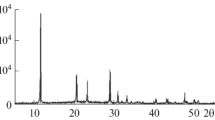Abstract
Aluminium oxide gel and aluminium oxide-silica gels of different compositions were prepared and activated at different temperatures. The adsorption of NH3 was studied in a McBain type balance at 20 torr and 5×10−3 torr at 25°. The thermodesorption of NH3 was studied at 5×10−3 torr between 25 and 550° at a constant heating rate of 4°/min. The desorption was followed by recording the thermogravimetric curve and the pressure oscillations in the system (p — T curve). The influence of composition and activation temperature is discussed. Chemisorption of a monomolecular layer is assumed in three main types of pores, together with the formation of a second monomolecular layer held by hydrogen bonds.
Résumé
On a préparé des gels d'oxyde d'aluminium et des gels de silice et d'oxyde d'aluminium de diverses compositions; les préparations ont ensuite été activées à différentes températures. On a étudié l'adsorption de NH3 à l'aide d'une balance de type McBain à 25° sous des pressions de 20 et de 5.103torr ainsi que la désorption thermique sous 5.10−3 torr entre 25 et 550° avec une vitesse de chauffage de 4°/mn. On a suivi la désorption en enregistrant les courbes thermogravimétriques et les oscillations de pression dans le système (courbesp — T). On a discuté l'influence de la composition et de la température d'activation. On suppose une chemisorption d'une couche monomoléculaire dans trois types principaux de pores ainsi que d'une seconde couche monomoléculaire maintenue par ponts d'hydrogène.
Zusammenfassung
Aluminiumoxyd und Aluminiumoxyd-Kieselsäure Gele von verschiedener Zusammensetzung wurden erzeugt und bei unterschiedlichen Temperaturen aktiviert. Die Adsorption von NH3 wurde mit Hilfe einer McBain Waage unter 20 und 5 · 10−3 Torr Druck bei 25°, weiterhin die Thermodesorption von NH3 unter 5 · 10−3 Torr Druck zwischen 25 und 550° mit 4°/Min. Aufheizungsgeschwindigkeit untersucht. Die Desorption wurde durch die thermogravimetrische Kurve und durch Registrieren der Druckschwankungen in dem System (p — T Kurve) verfolgt. Man diskutiert den Einfluß von Zusammensetzung und Aktivierungstemperatur. Man nimmt eine Chemisorption einer monomolekularen Schicht in drei Porenhaupttypen gemeinsam mit der Ausbildung einer zweiten durch Wasserstoffbindungen gebundenen monomolekularen Schicht an.
Резюме
Приготовлен гельоки си алюминия и окись алюминия-силикагелы различного состава и активирова ны при различных темп ературах. Изучена адсорбция ам миака (NH3) на весах типа Мак Бен п ри 20 мм рт. ст. и 5 · 10−3 мм рт. ст. и температура 25°. Изучен а термодесорбция при 5 · 10−3 мм рт. ст. в пределах температур 25° – 550° при п остоянной скорости нагрева 4°/ми н. Десорбция сопровож дается регистрированием те рмогравиметрическо й кривой и осцилляцией давления в системе (p—T к ривая). Обсуждено влияние состава и температур ы активации. Высказан о предположение о нали чии мономолекулярно го слоя в трех главных ти пах пор, вместе с образ ованием второго мономолекул ярного слоя, удерживаемого в одородными связями.
Similar content being viewed by others
References
G. A. Mills, A. C. Oblad andI. Boedecker, J. Am. Chem. Soc., 72 (1950) 1559.
R. L. Richardson andS. W. Benson, J. Phys. Chem., 61 (1957) 4051.
H. Dunken andP. Fink, Z. Chem., 5 (1965) 433, 471.
H. Dunken andP. Fink, Chem. Techn., 18 (1966) 490.
H. Dunken andP. Fink, Acta Chim. Acad. Sci. Hung., 53 (1967) 179.
B. Camara, H. Dunken andP. Fink, Z. Chem., 8 (1968) 155.
N. W. Cant andL. H. Little, Nature, 211 (1966) 69.
N. W. Cant andL. H. Little, Can. J. Chem., 46 (1968) 1373.
G. F. Braggio andG. Farne, Chim. Ind., 50 (1968) 1106.
N. W. Cant andL. H. Little, J. Catal., 12 (1968) 134.
M. Prettre, Study Weak Mol. Forces, 9 1966 (Publ. 1967) 523.
G. Farne, N. Pernicone andF. Braggio, Atti Acad. Naz. Lincei, Rend, Cl. Sci. Fis. Mat. Natur., 45 (1968) 373.
R. Grecu, Stud. Cercet. Chim., 17 (1969) 493.
P. Pichart, M. Mathieu andB. Imelik, J. Chim. Phys. Physicochim., Biol., 66 (1969) 845.
O. V. Bulgakov, A. V. Uvarov andT. V. Antipina, Zh. Fiz. Khim., 44 (1970) 17.
C. Clement, Rev. Inst. Fr. Petrol Ann. Combust. Liquids, 22 (1967) 994.
G. Fabbri, Corsi Semin. Chim., 7 (1967) 82.
M. W. Tamele, Disc. Farad. Soc., 8 (1950) 270.
A. E. Hirschler, J. Catal., 6 (1966) 1.
A. N. Webb, Ind. Eng. Chem., 49 (1957) 261.
R. T. Barth andE. V. Ballon, Anal. Chem., 33 (1961) 1081.
J. Hille, Chem. Techn., 18 (1966) 466.
J. E. Benson, K. Ushiba andM. Boudart, J. Catal., 9 (1967) 91.
J.Bandiera and C.Naccachae, Bull. Soc. Chim. France, (1969) 2637.
A. C. Zettlenmayer andJ. J. Chessik, J. Phys. Chem., 64 (1960) 1131.
V. Kevorkian andR. O. Steiner, J. Phys. Chem., 67 (1963) 545.
L.Whalley, Thesis, Bristol Univ., (1964).
Y. Kubokawa, J. Phys. Chem., 67 (1963) 769.
I. C. Stone andL. Whilley, J. Catal., 8 (1967) 173.
N. N. Avgul, A. V. Kiselev, L. Ya. Kudyukova andM. V. Serdobov, Zh. Fiz. Khim., 42 (1968) 188.
B. G. Aristov, S. P. Dzhavadov andA. V. Kiselev, Kolloid Zh., 30 (1968), 183.
G. Bliznakov, P. Markov andI. Bakardzhiev, Izd. Otd. Khim. Nauki Bulg. Akad. Nauk, 1 (1968) 139.
G. Bliznakov, J. Res. Inst. Catal. Hokkaido Univ., 16 (1968) 195.
H. S. Stach, T. Penize, K. Fiedler andW. Schirmer, Z. Chem., 10 (1970) 229.
W. Schirmer, A. Grossmann, K. Fiedler, K. H. Sahhart andM. Bülow, Chem. Techn., 22 (1970) 405.
K. Pohl andG. Rebentisch, Z. Chem., 5 (1965) 396.
Author information
Authors and Affiliations
Rights and permissions
About this article
Cite this article
Pop, A., Kröbl, P. & Jozsa, P. Influence of composition and of activation temperature upon the adsorption and thermodesorption of ammonia on aluminium oxide-silica gels. Journal of Thermal Analysis 4, 451–459 (1972). https://doi.org/10.1007/BF01913802
Received:
Revised:
Issue Date:
DOI: https://doi.org/10.1007/BF01913802




